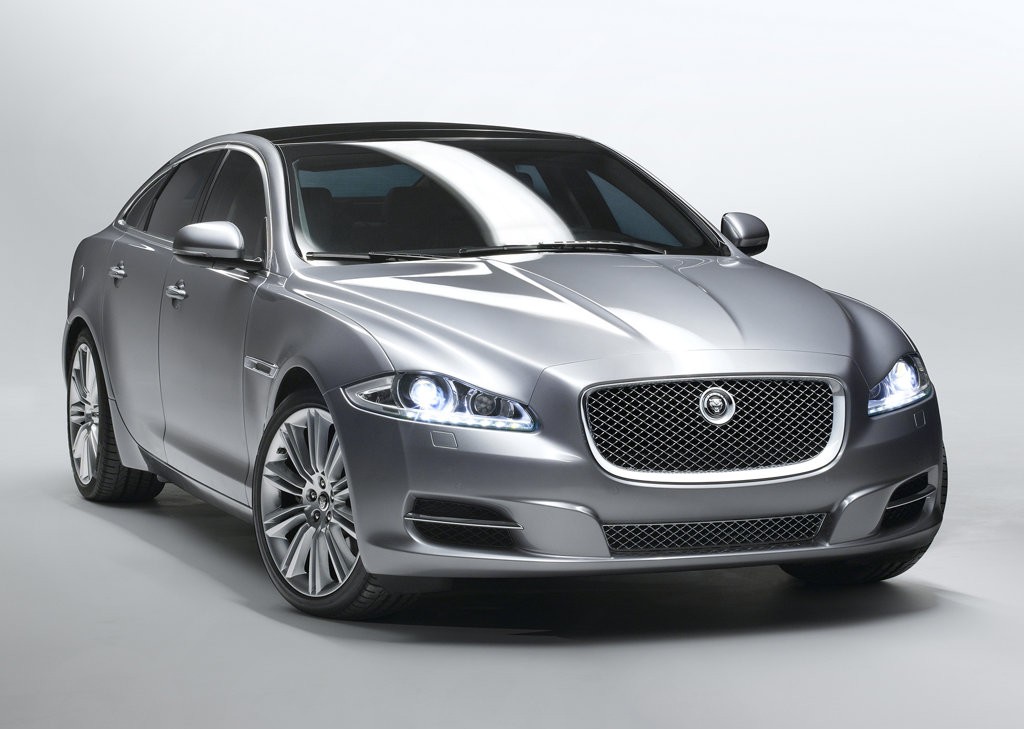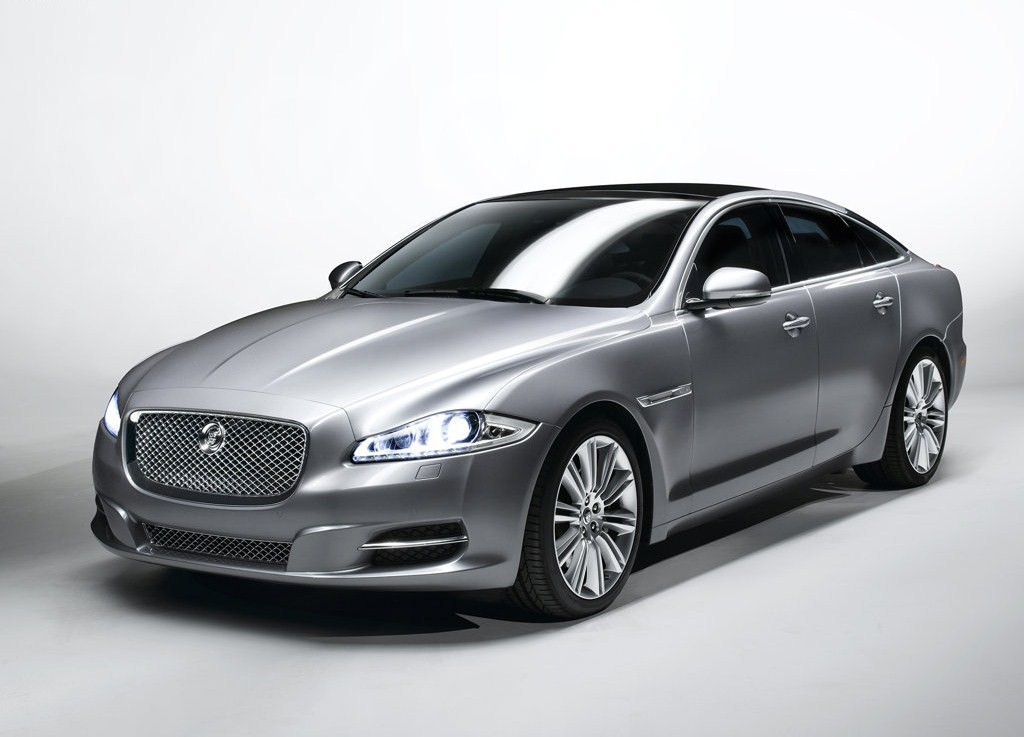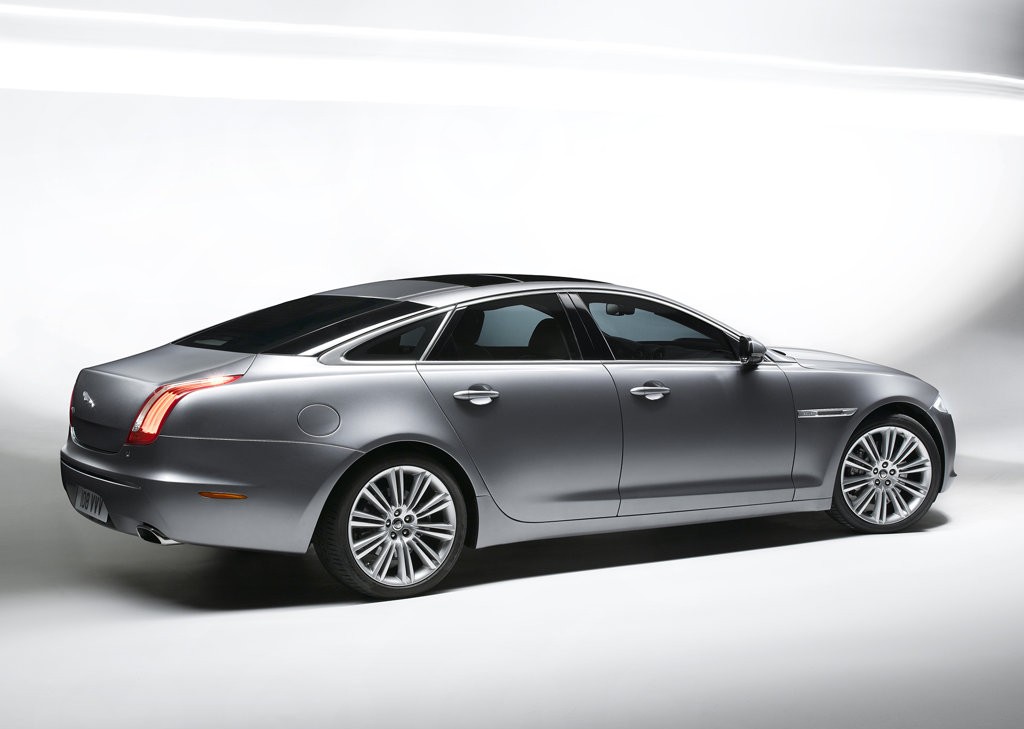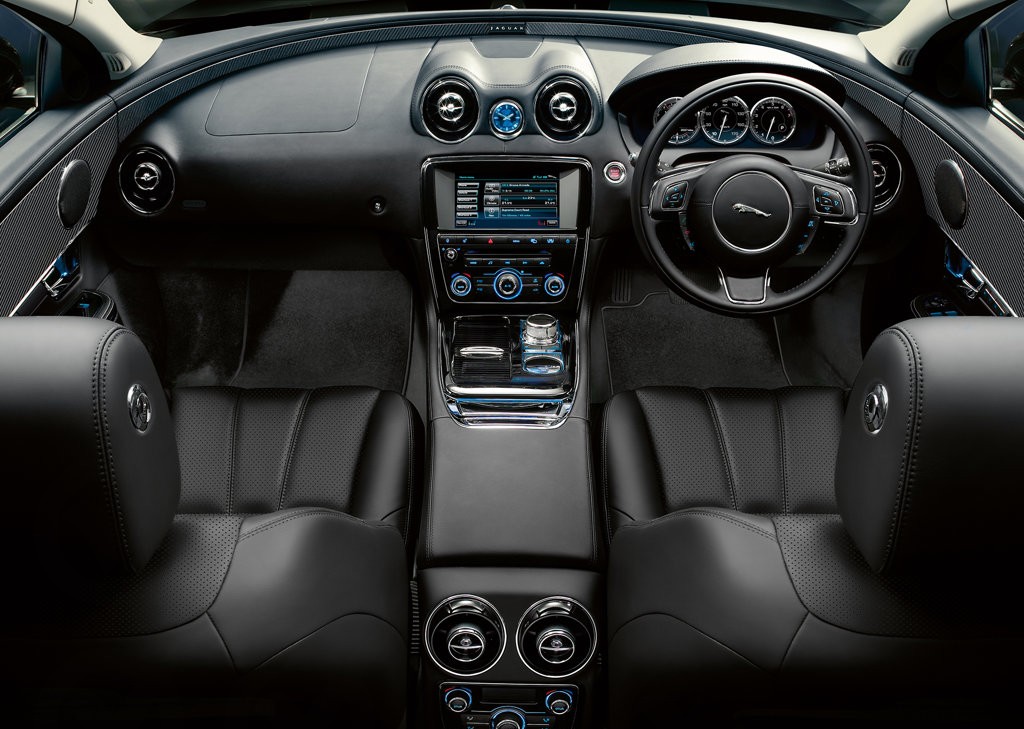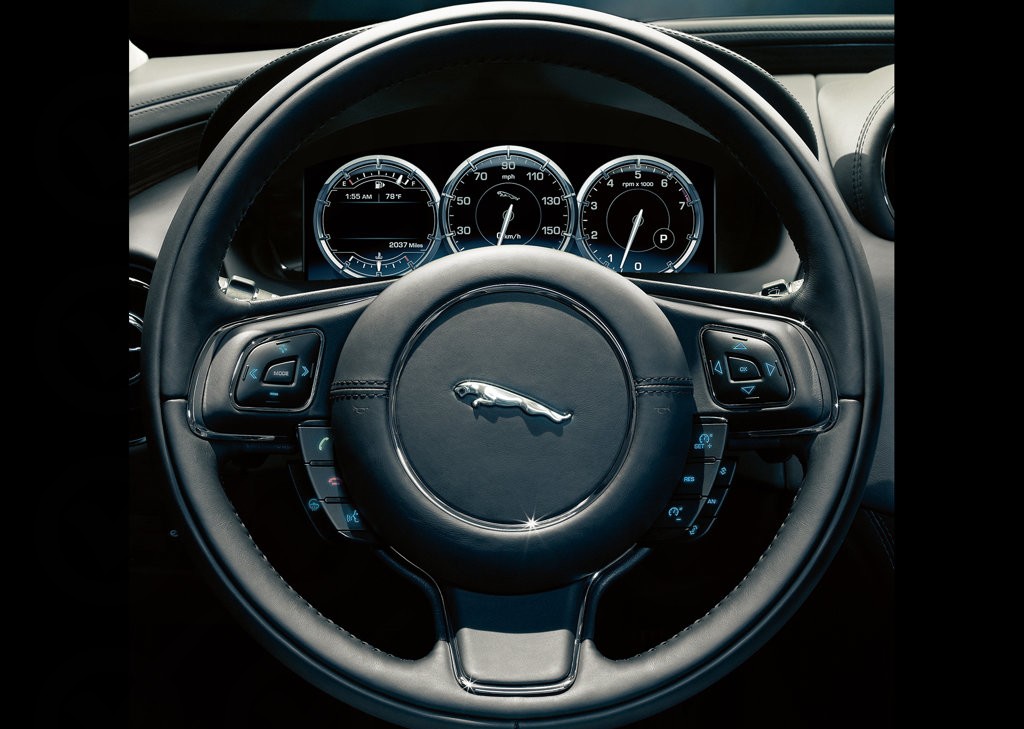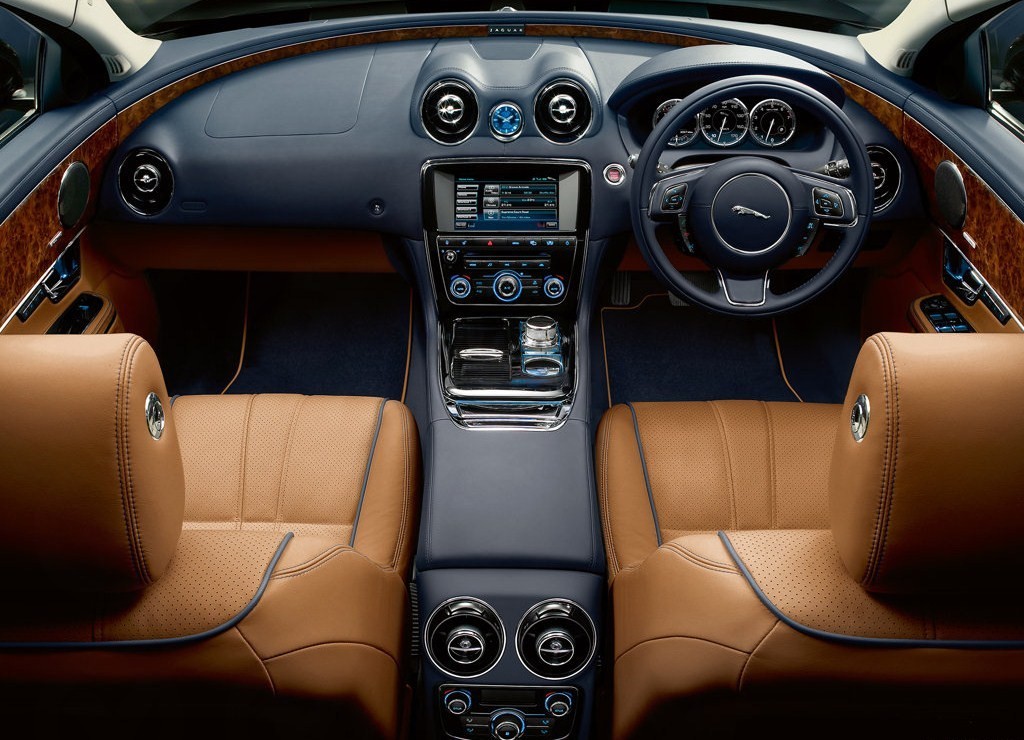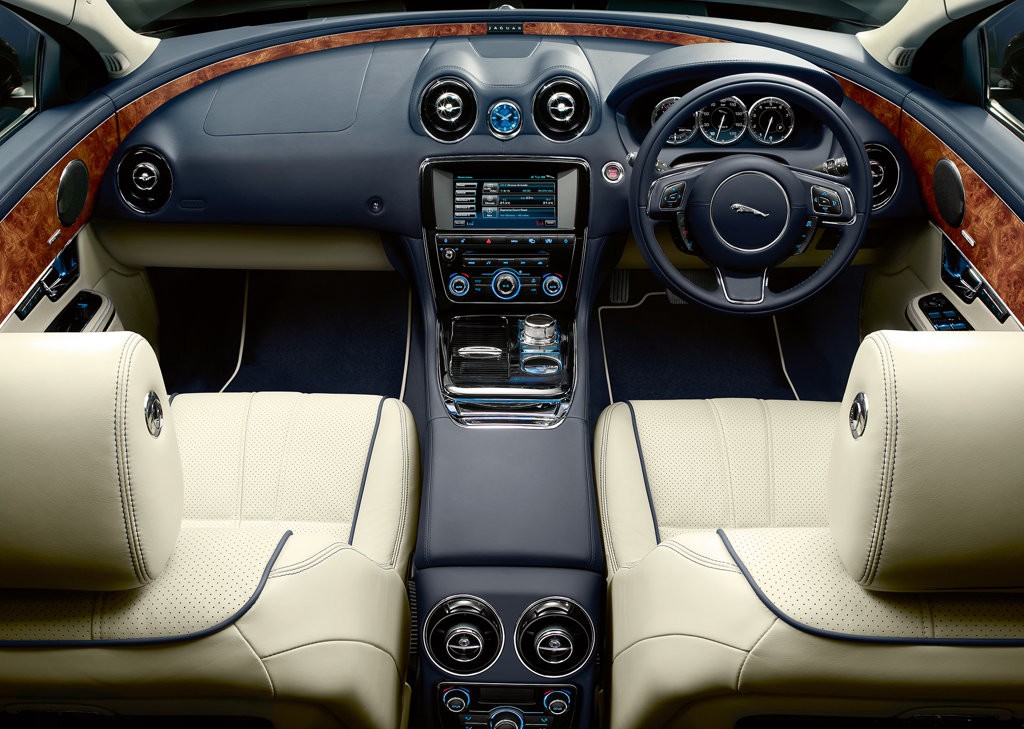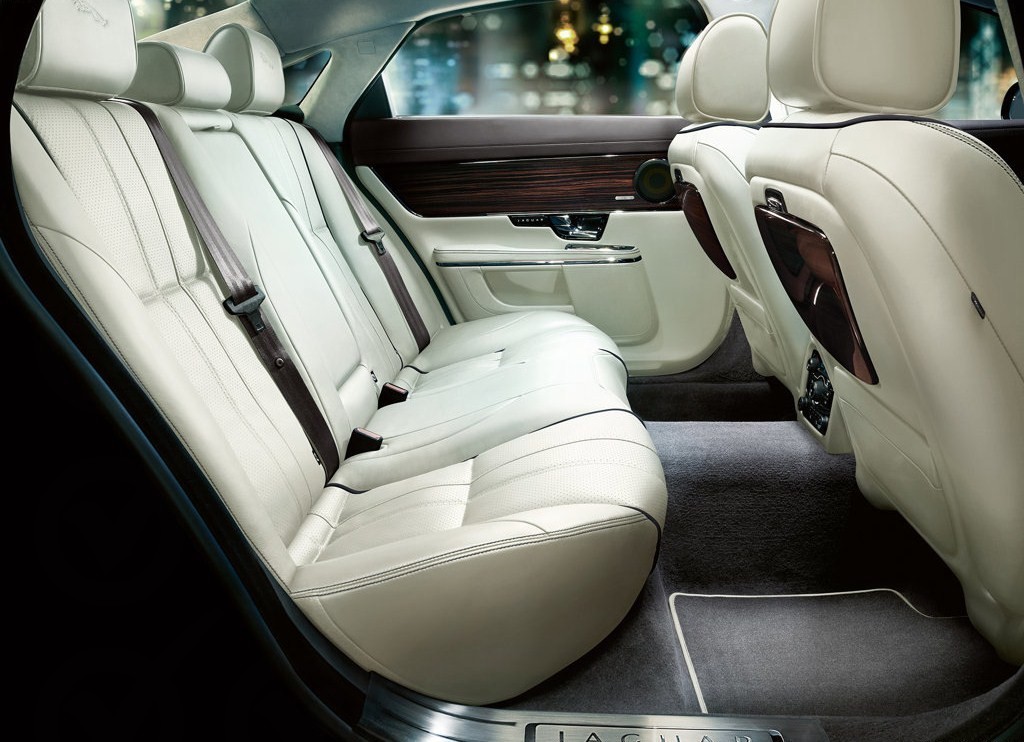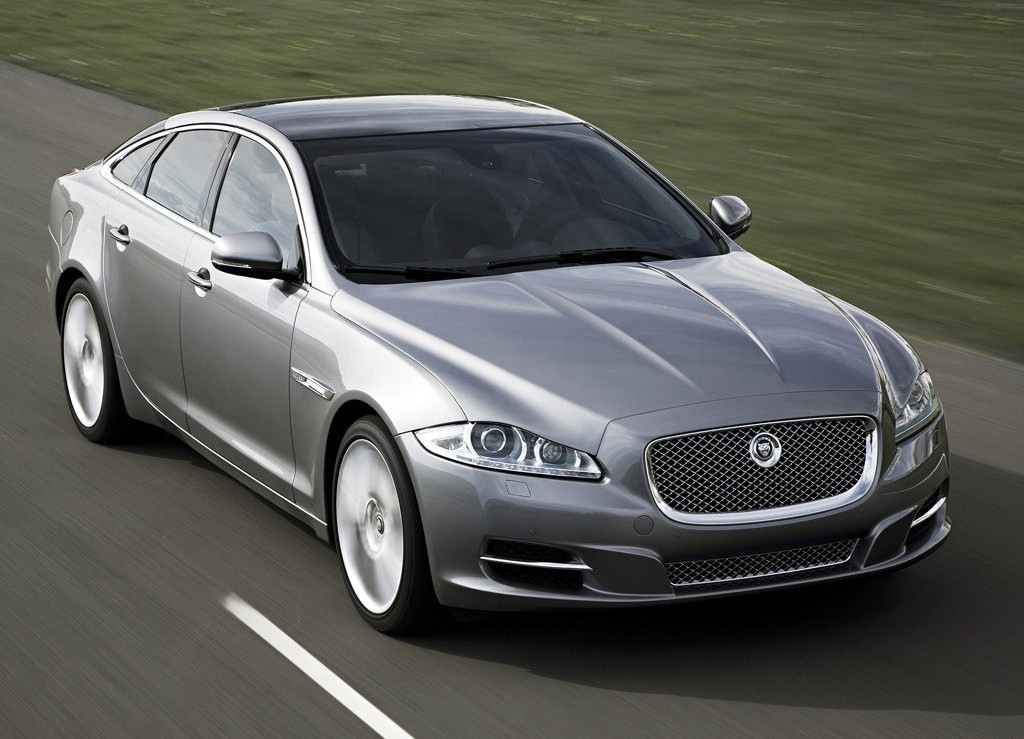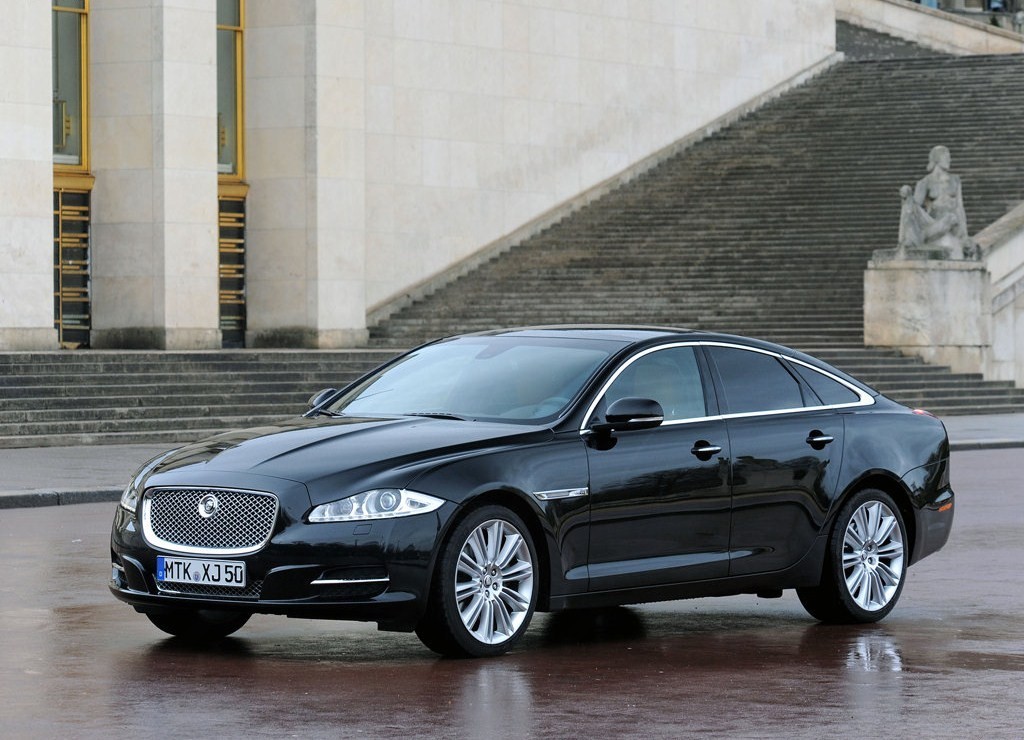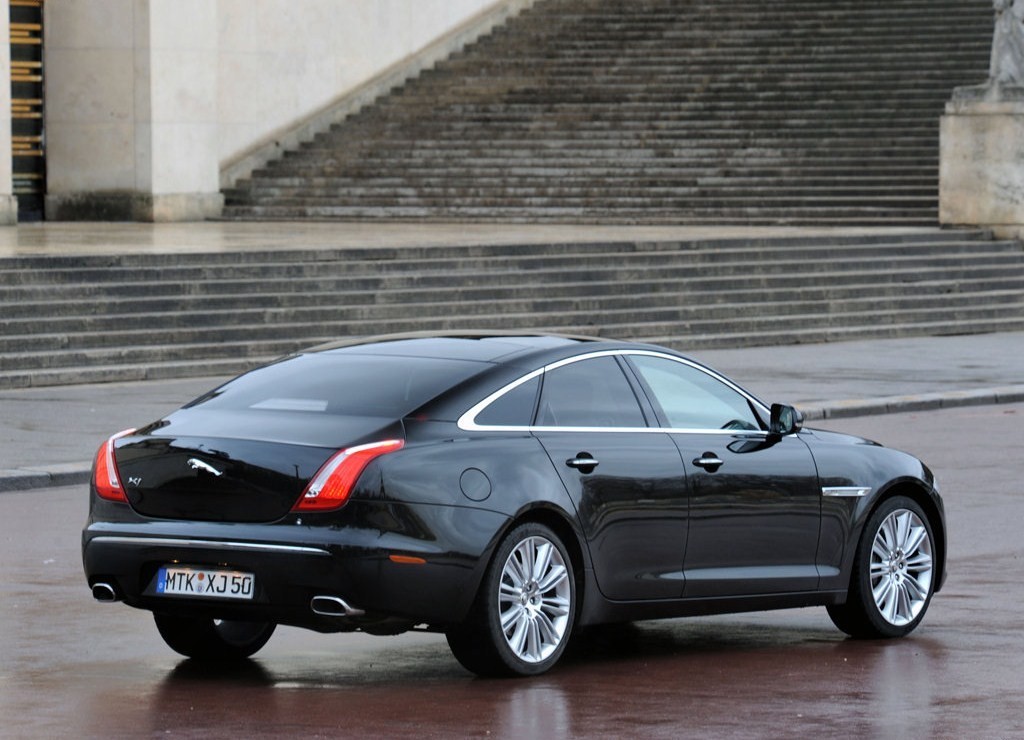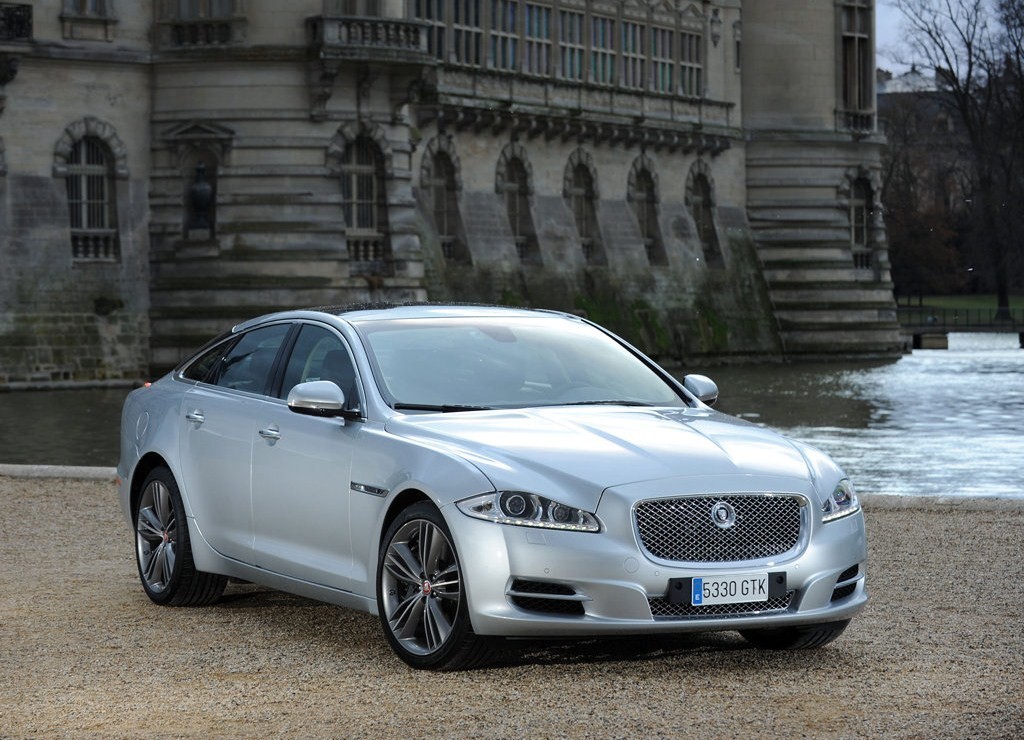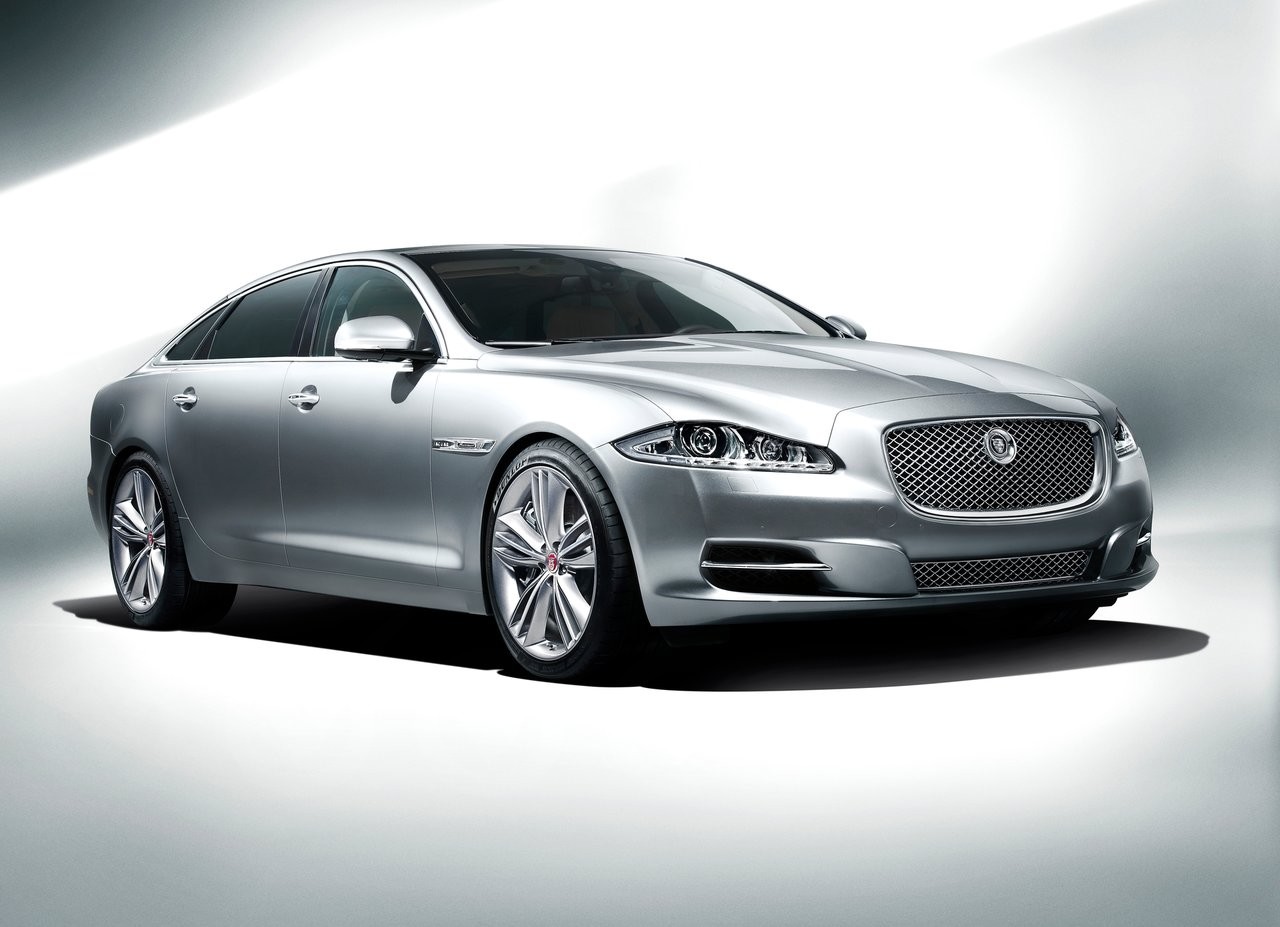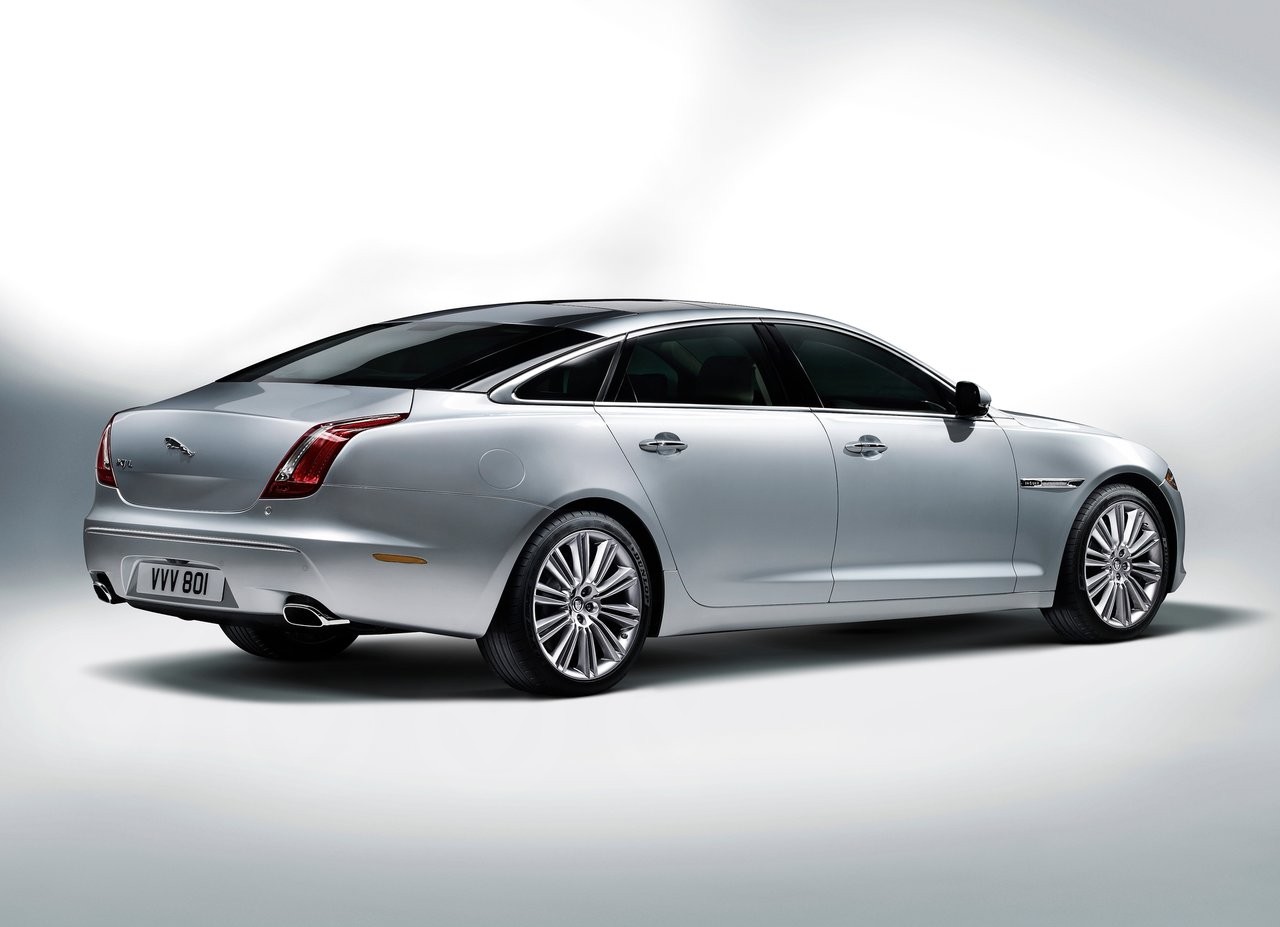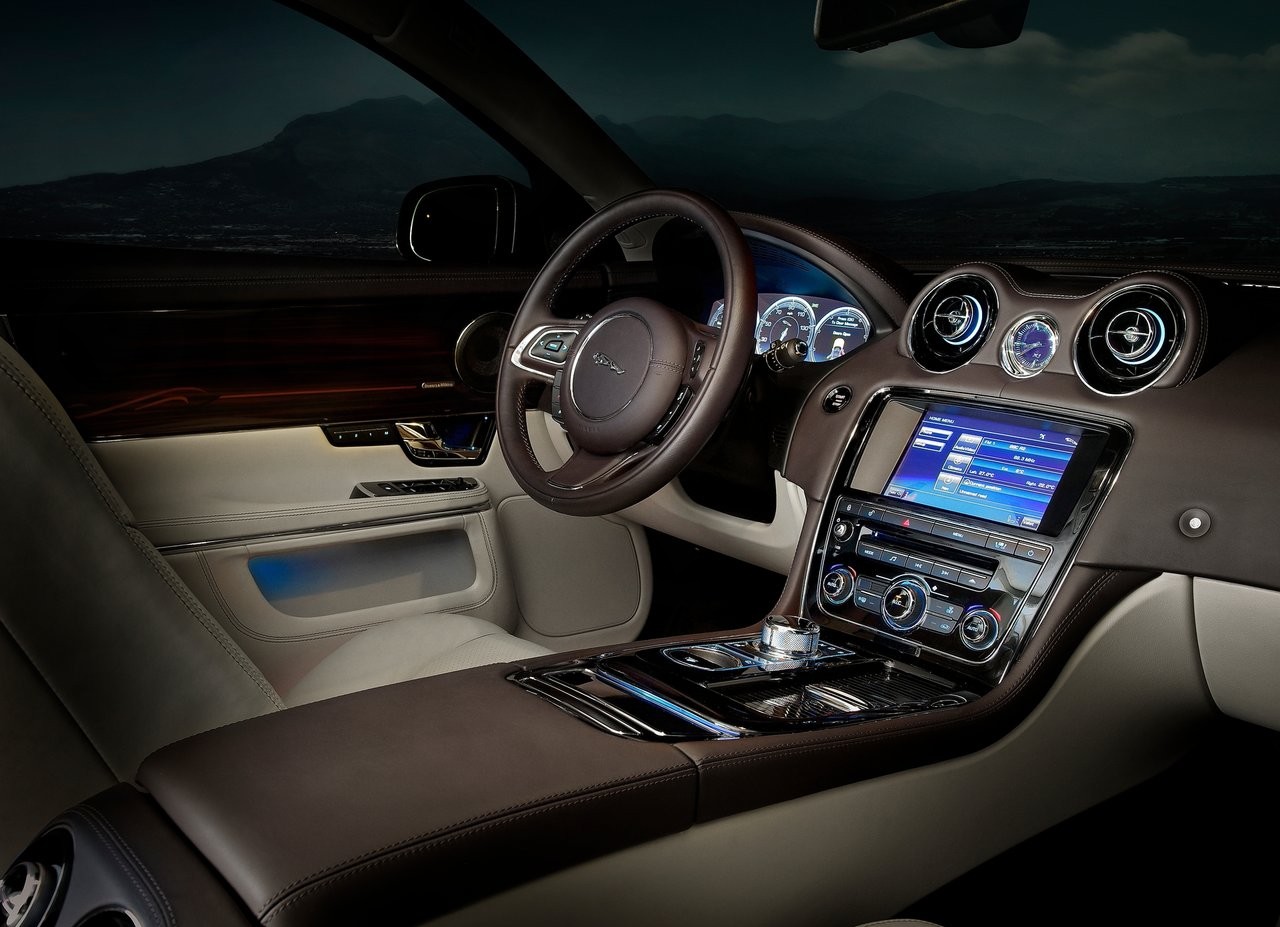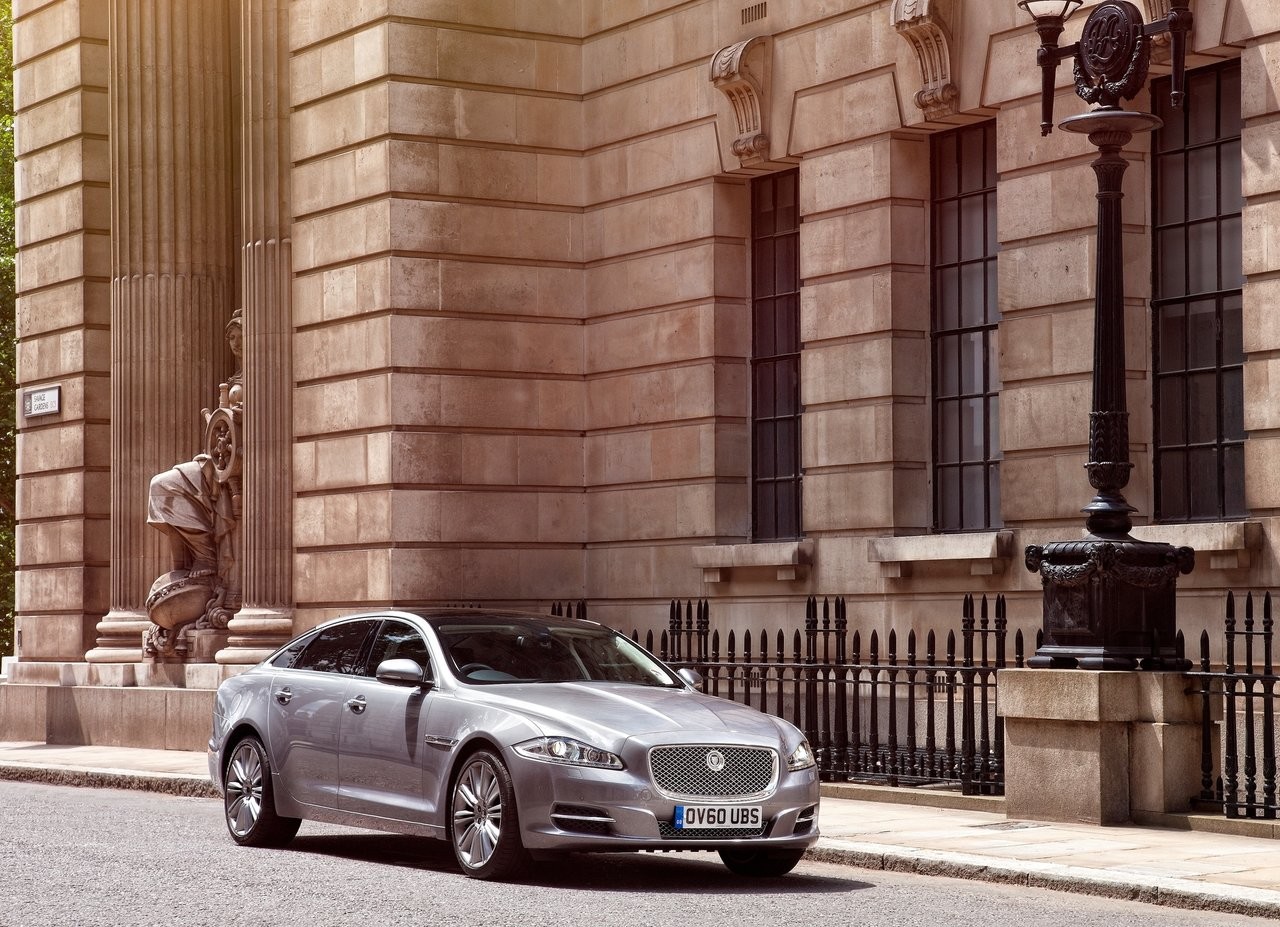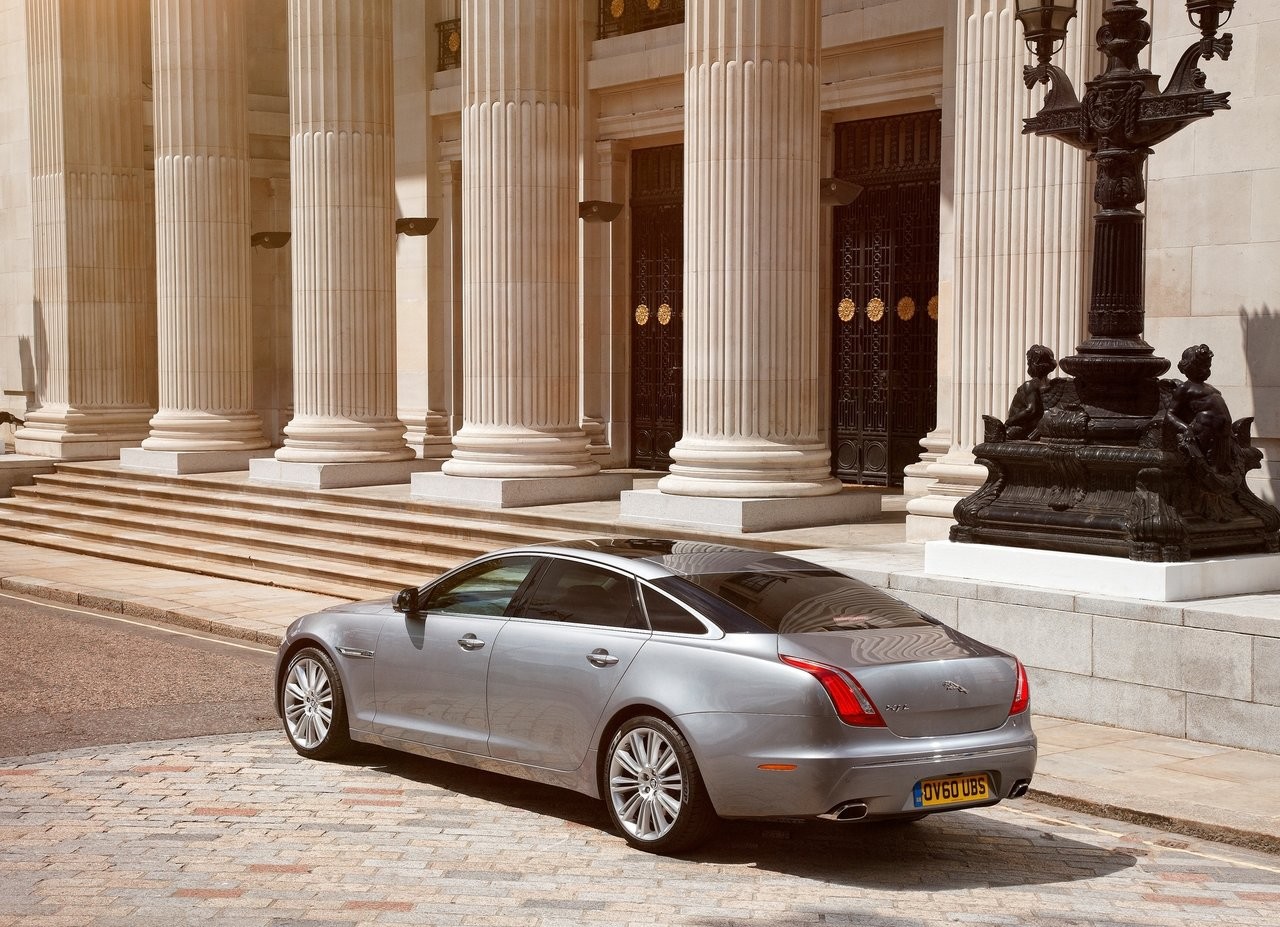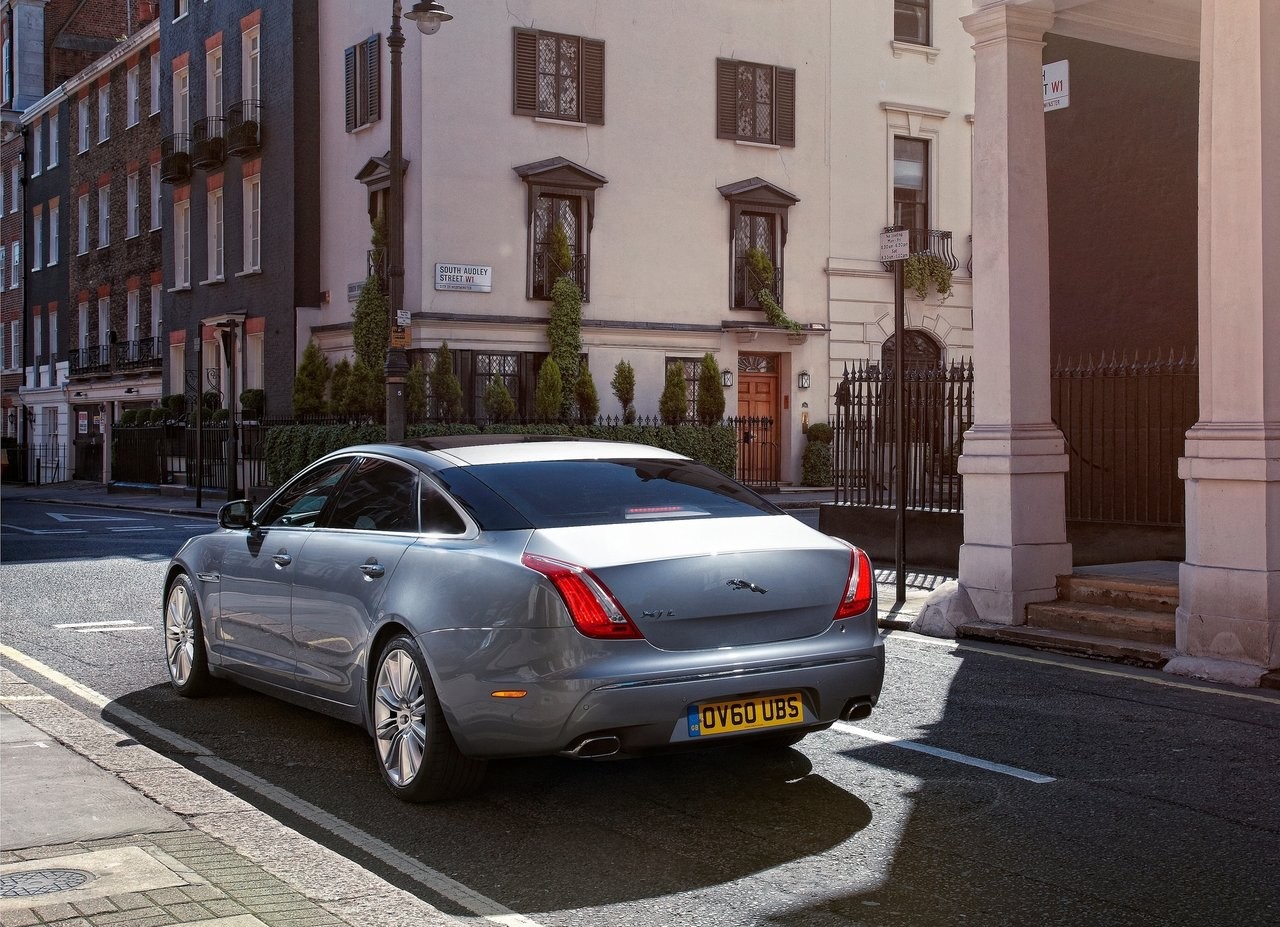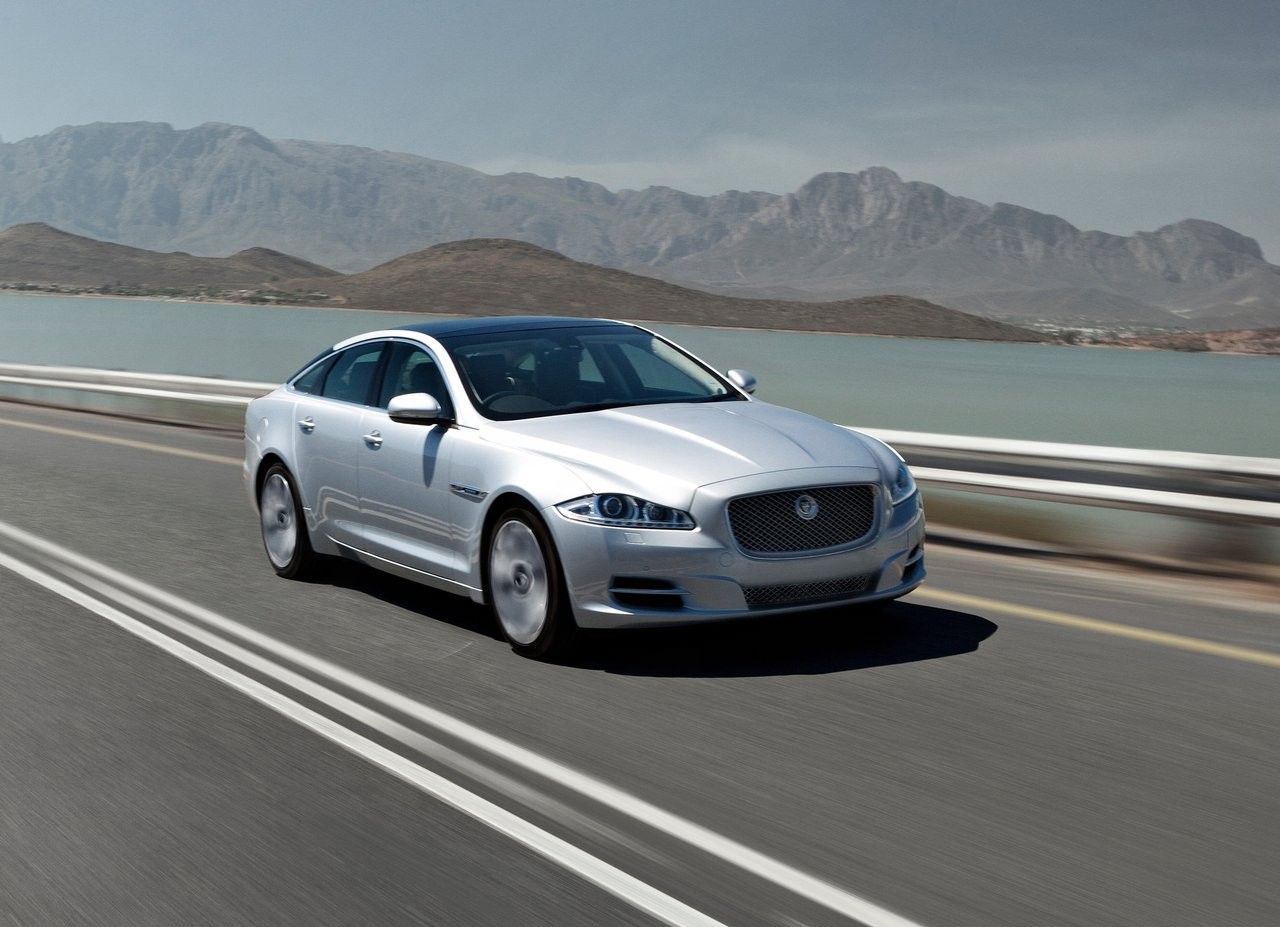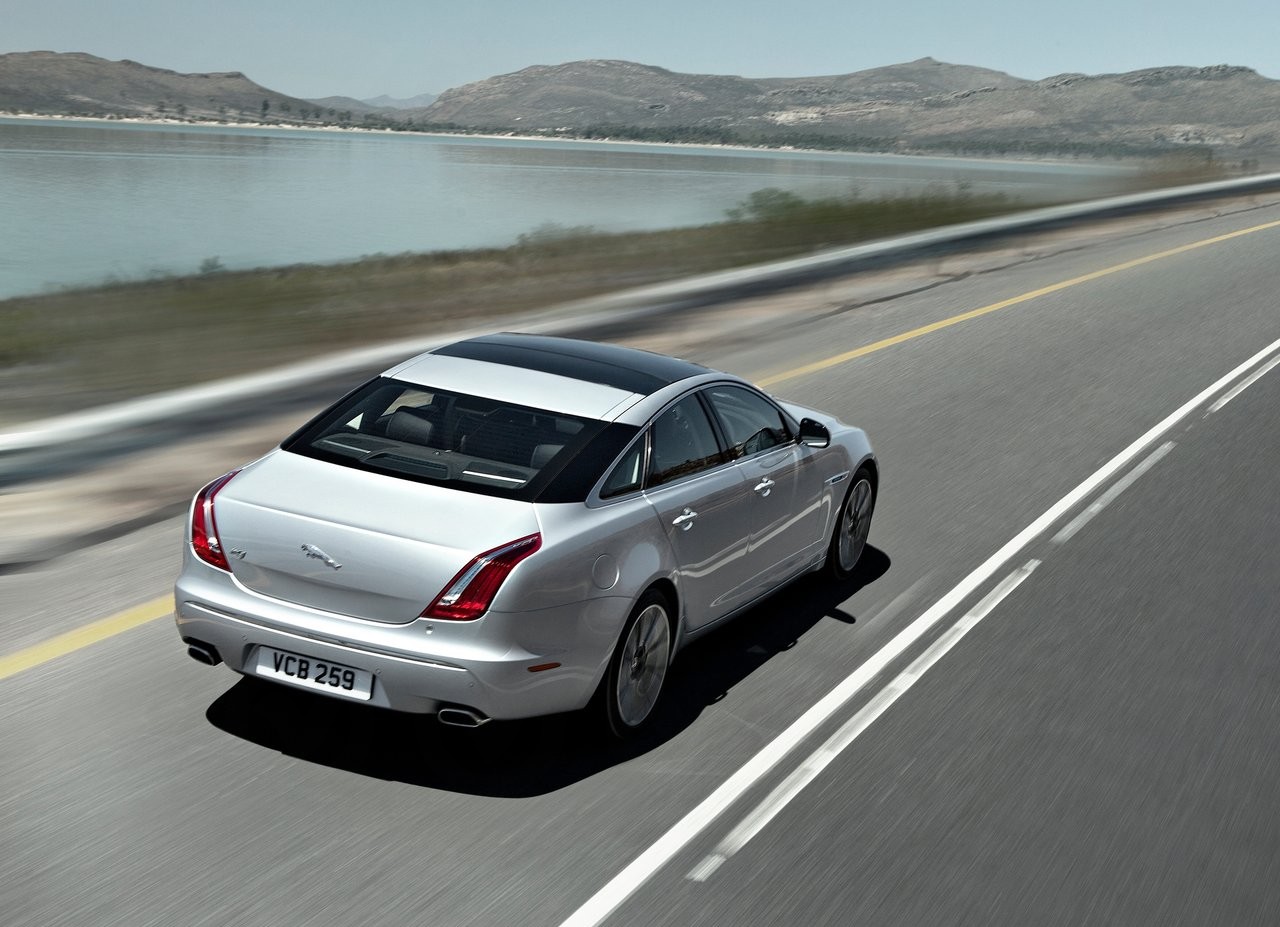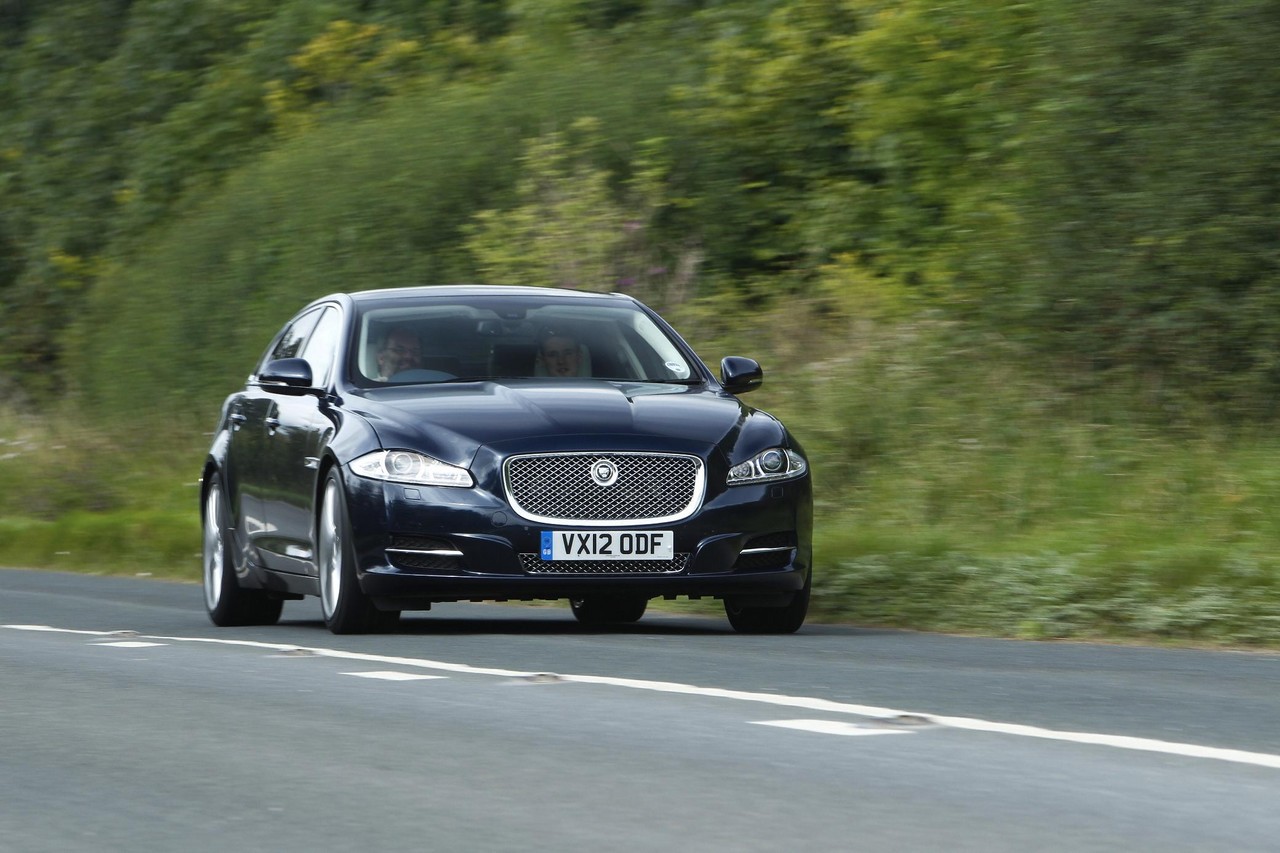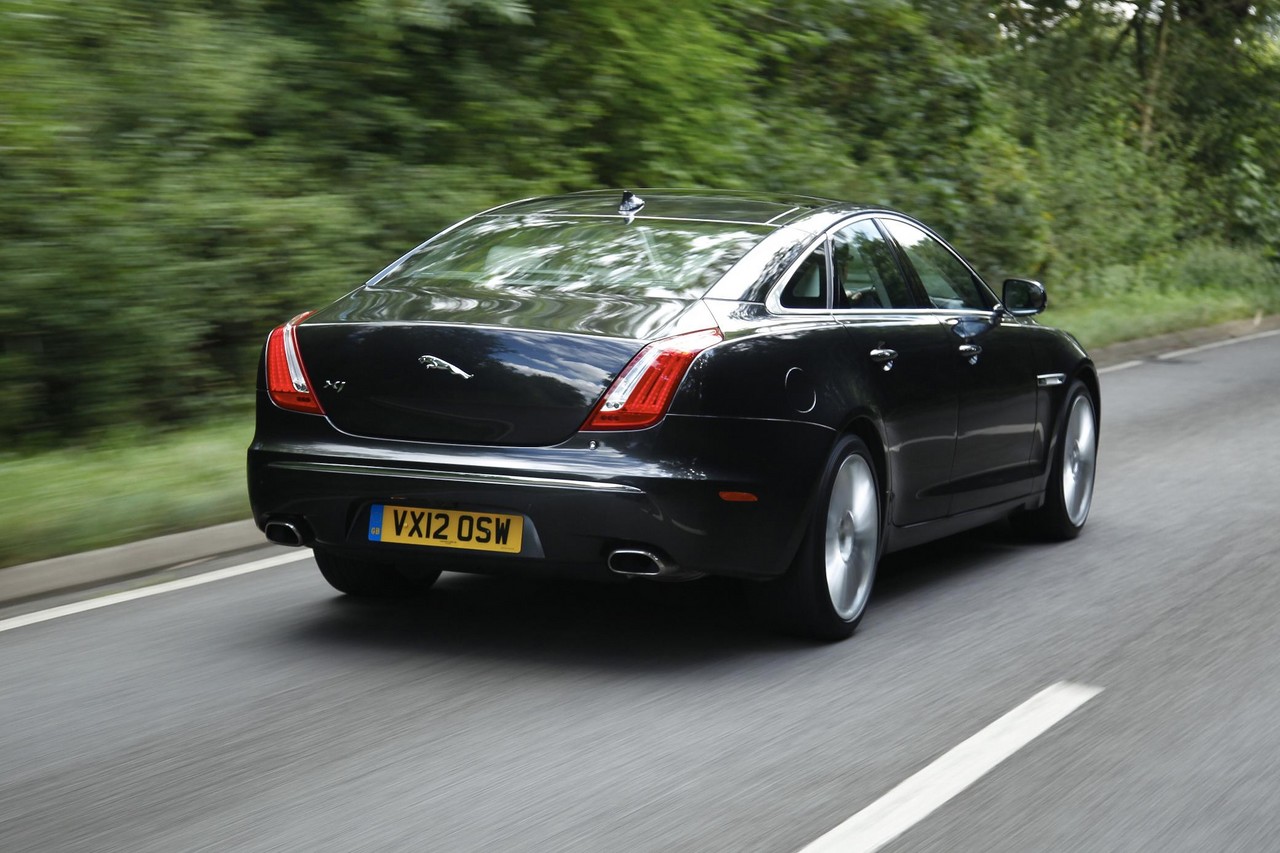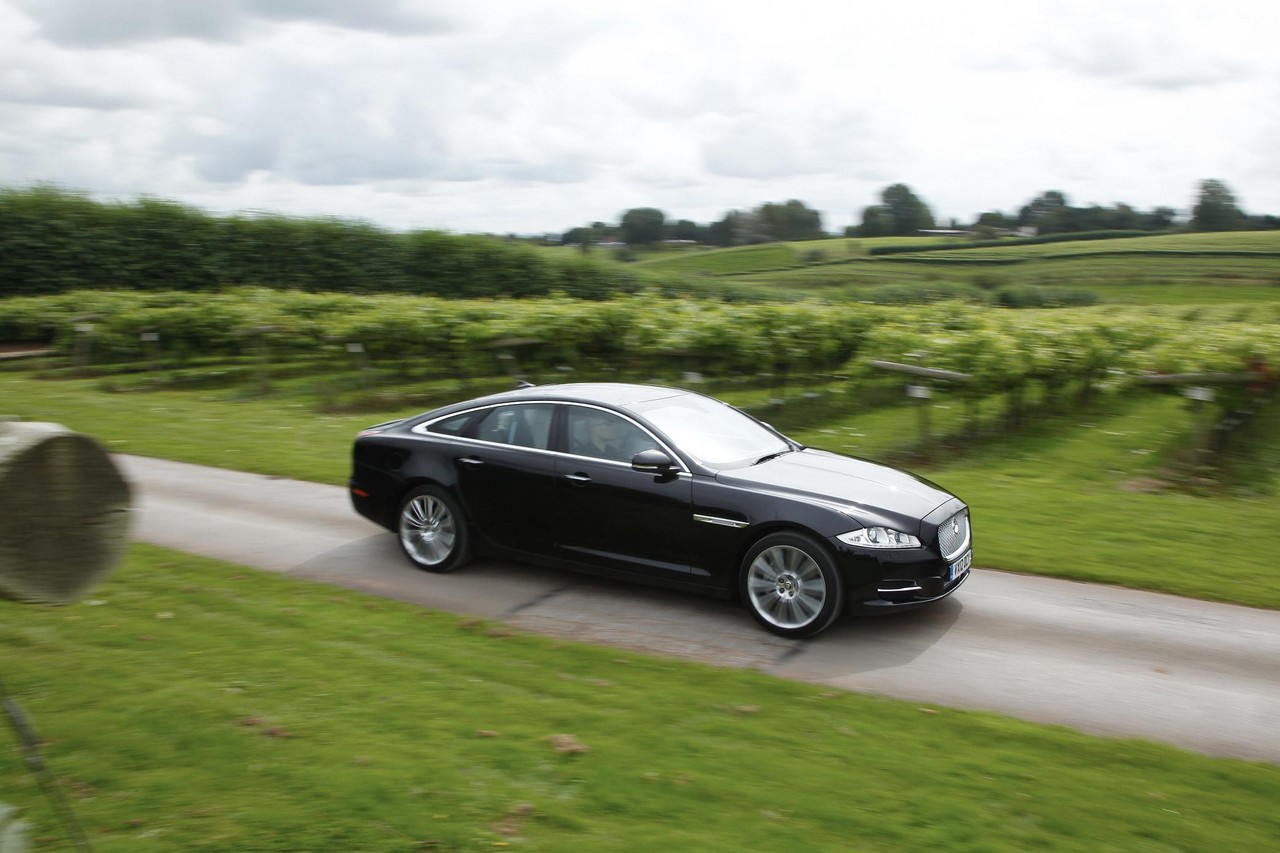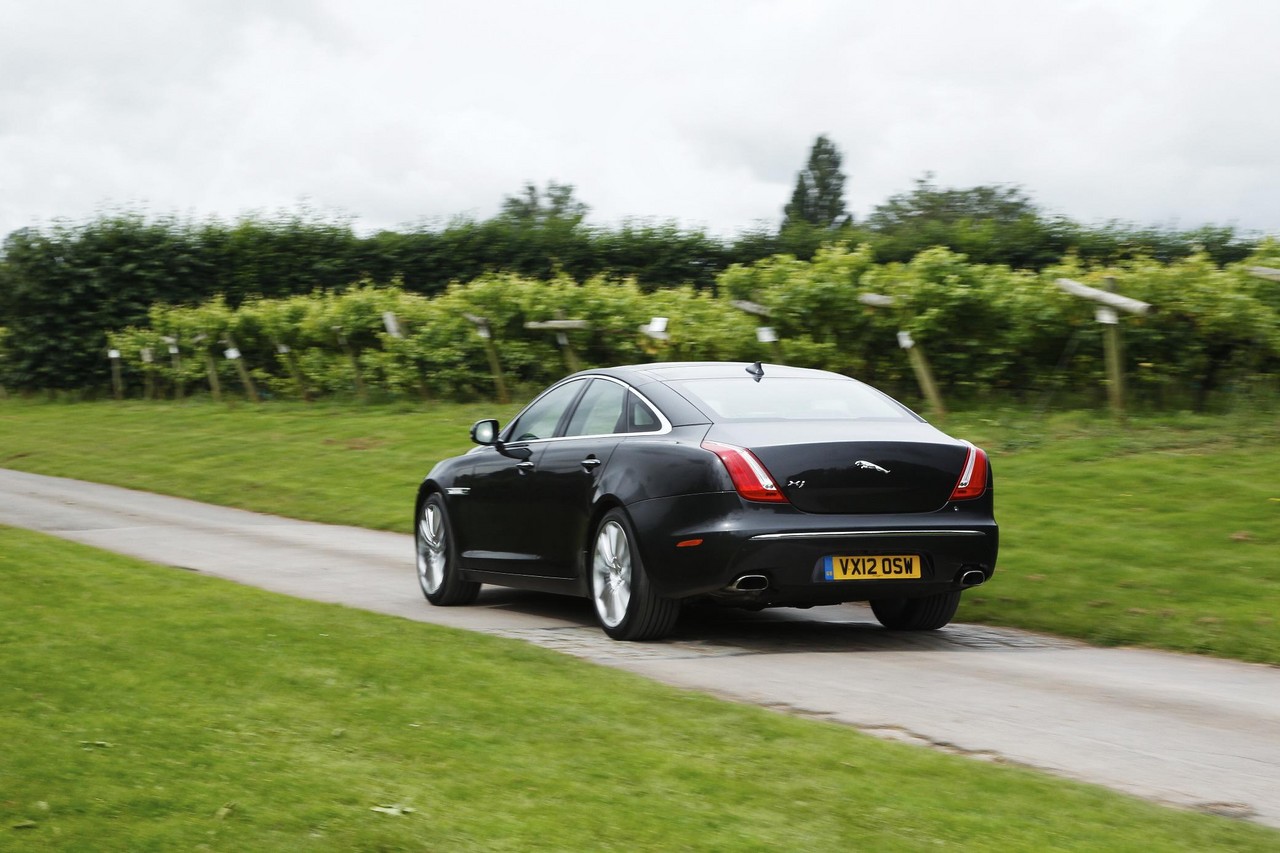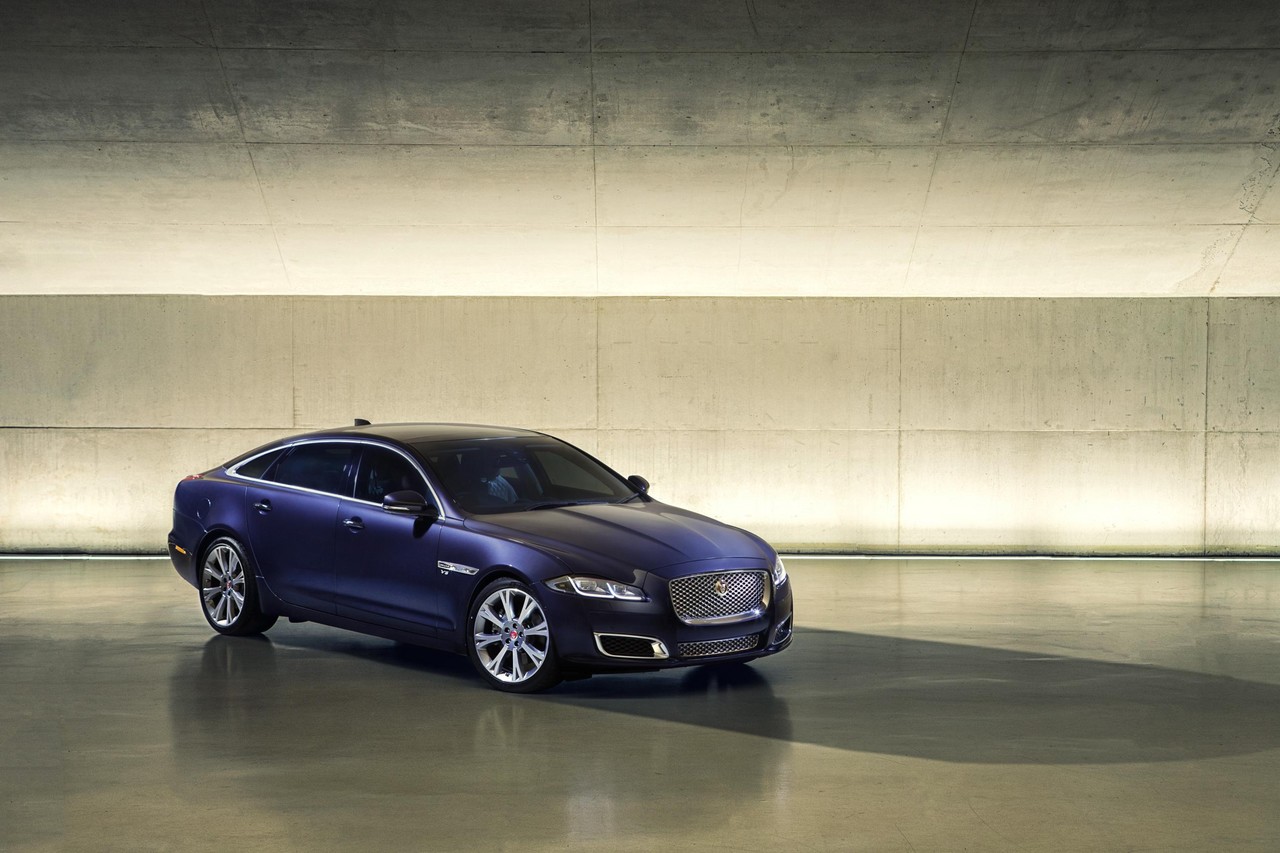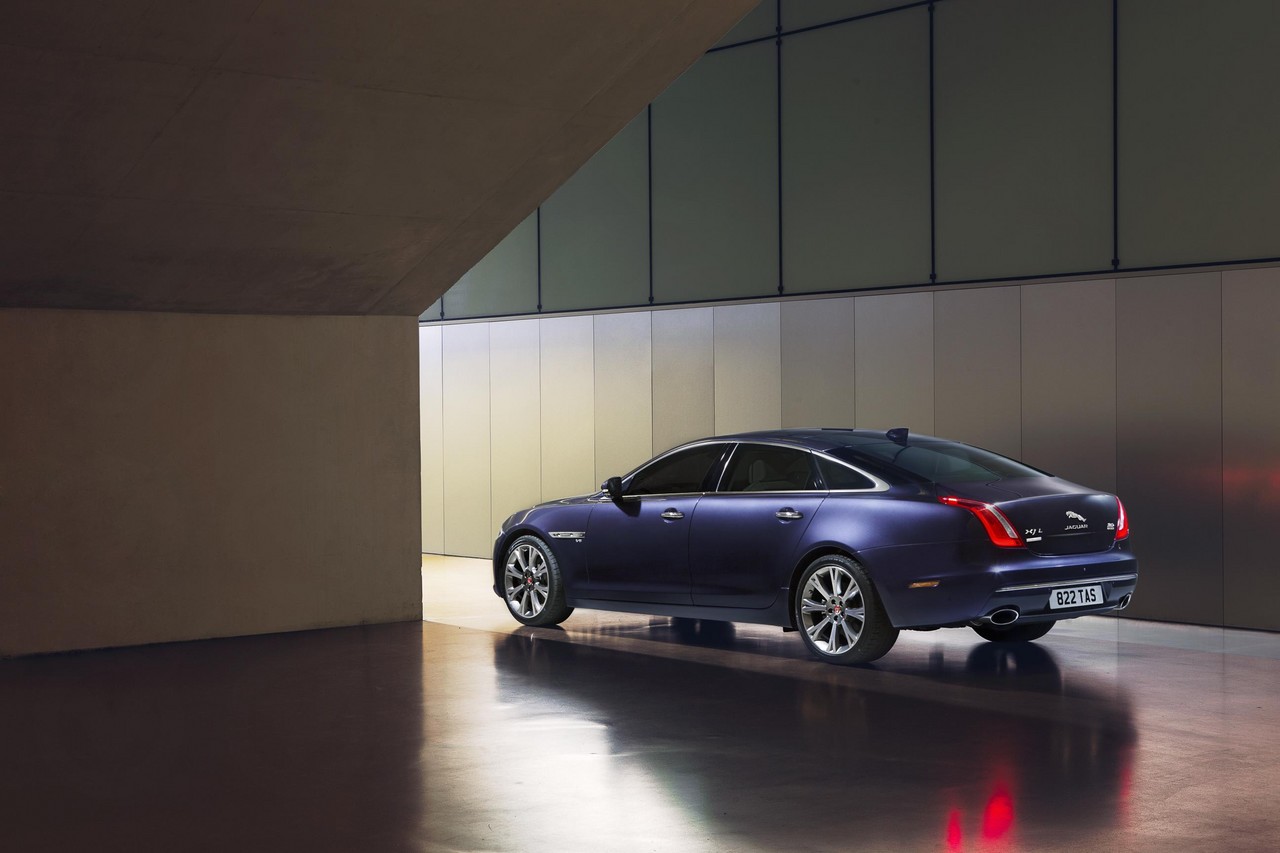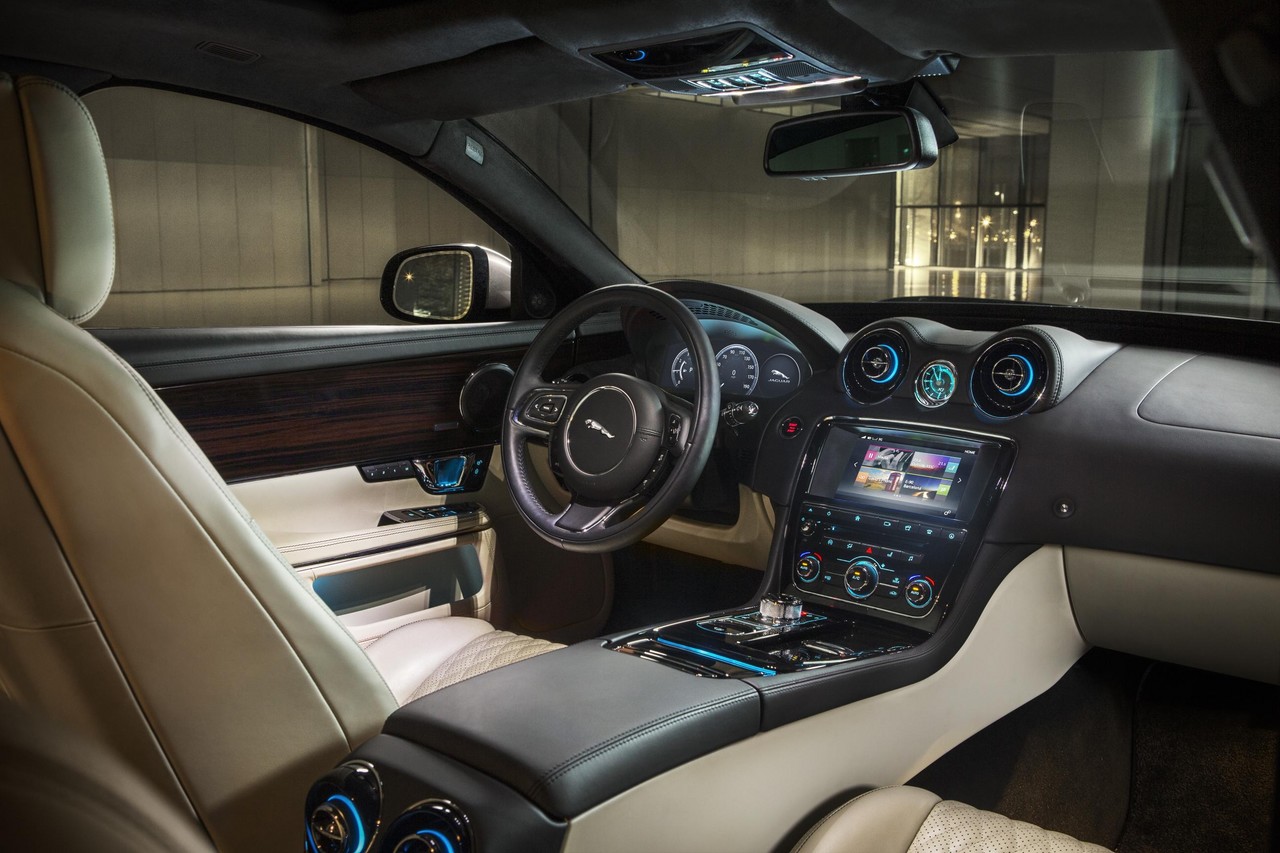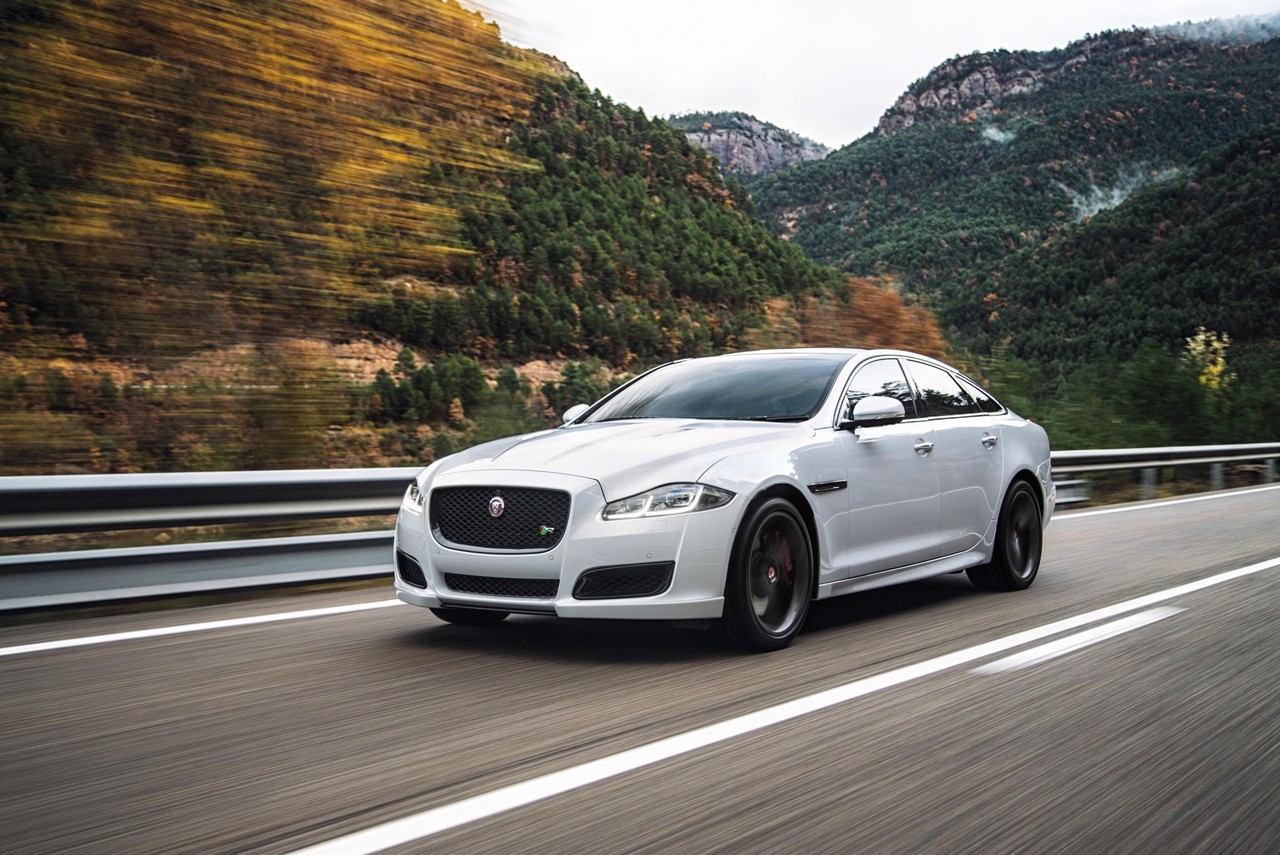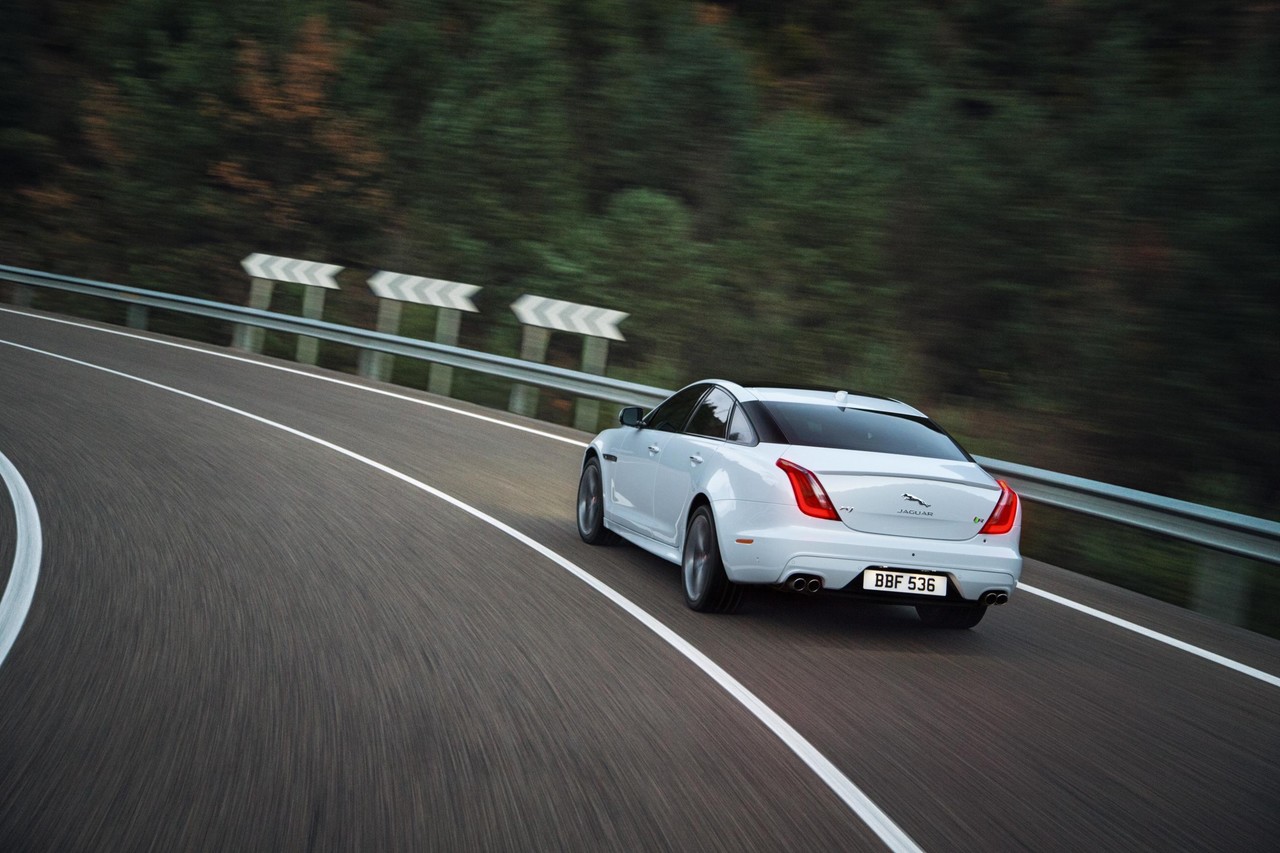
- Range of responsive engines
- High standard of interior fit and finish
- Lightweight aluminium body contributes to agility
- Generally impressive ride/handling balance…
- … though ride suffers on 20-inch wheels
- Limited rear headroom
- Significant and ongoing depreciation
Review: Jaguar X351.I XJ (2010-12)
Overview
Released in July 2010, the Jaguar X351 Series I (X351.I) XJ was a large, luxury sedan. Manufactured in Castle Bromwich, England, the rear-wheel drive XJ was available with 3.0-litre turbo-diesel and 5.0-litre V8 engines, with the latter available in naturally aspirated and supercharged forms.
AJD-V6 and AJ133 engines
Of the engines,
- the 3.0-litre AJD-V6 turbo-diesel engine had a compacted graphite iron (CGI) block, common-rail direct injection (maximum pressure of 2000 bars), piezo injectors, two variable geometry turbochargers, an air-to-air intercooler, double overhead camshafts, four valves per cylinder and a compression ratio of 16.4:1. The turbochargers had parallel sequential operation such that the primary turbocharger at low rpm and the smaller, secondary turbocharger supplied the primary with compressed air from 2800 rpm; and,
- the 5.0-litre AJ133 V8 engine had a die-cast aluminium block with cast-in iron liners and cross-bolted main bearing caps, spray-guided direct injection, graphite cast-iron crankshafts, forged steel connecting rods, double overhead camshafts (per cylinder bank), dual independent variable cam timing (DIVCT) and four valves per cylinder. While the naturally-aspirated engines also had camshaft profile switching (CPS) on the inlet camshaft, a variable inlet manifold and a compression ratio of 11.5:1, the supercharged engines had a Roots-type twin vortex supercharger, twin water-cooled intercoolers and had a compression ratio of 9.5:1.
All engines were mated to a six-speed ZF automatic transmissions.
| Variant | Engine | Edition | W/b | Trans. | Peak power | Peak torque |
|---|---|---|---|---|---|---|
| 3.0D | 3.0-litre twin-turbo-diesel V6 | Premium Luxury | SWB, LWB |
6sp auto | 202 kW at 4000 rpm | 600 Nm at 2000 rpm |
| 5.0 V8 | 5.0-litre petrol V8 |
Premium Luxury | SWB, LWB |
6sp auto | 283 kW at 6500 rpm | 515 Nm at 3500 rpm |
| Portfolio | SWB | |||||
| 5.0S V8 | 5.0-litre s/charged petrol V8 | Portfolio | SWB | 6sp auto | 346 kW at 6000-6500 rpm | 575 Nm at 2500-5500 rpm |
| 5.0S V8 | 5.0-litre s/charged petrol V8 | Supersport | SWB, LWB |
6sp auto | 375 kW at 6000-6500 rpm | 625 Nm at 2500-5500 rpm |
Dimensions
Compared to the Jaguar X350 XJ , the X351 XJ was 32 mm longer (at 5122 mm), 34 mm wider (1894 mm), the same height (1448 mm) and had a 2 mm shorter wheelbase (3032 mm for short and 3157 mm for long wheelbase models). Like the X350, the X351 had a monocoque structure made from pressed, cast and extruded aluminium alloy components with aerospace-based riveting and bonding processes; furthermore, the body itself had a 0.29 coefficient of drag.
Suspension
The Jaguar X351 XJ had unequal length wishbone front suspension (suspended by steel coil springs), while air suspension was limited to the multi-link rear. The X351 XJ also had electronically-controlled, continuously variable damping (‘Adaptive Dynamics’) with selectable modes.
Safety equipment
Standard safety features for the Jaguar X351 XJ included dual front airbags, front side airbags, full-length curtain airbags (i.e. for front and rear occupants), ABS, electronic brake force distribution, brake assist, electronic stability control, cornering brake control, traction control, active front seat head restraints and front seatbelts with pretensioners and load limiters. Furthermore, the XJ’s bonnet could also rise in the event of a pedestrian collision to cushion their impact.
In December 2012, standard safety equipment was extended to include a blind spot monitoring system.
Brakes
The standard braking package for the Jaguar X351 XJ consisted of 355 mm ventilated front disc brakes and 326 mm rear ventilated discs. The 5.0S V8 variants, however, were fitted with 380 mm front and 376 mm rear discs.
Features: Jaguar X351 XJ
Standard features for the Jaguar X351 XJ Premium Luxury editions included 19-inch ‘Aleutian’ alloy wheels, a fourteen speaker sound system with a CD/DVD player, auxiliary inputs (3.5 mm/USB/iPod), MP3/WMA compatibility and hard-drive for music storage, dual-zone climate control air conditioning, satellite navigation, power adjustable and heated front seats, soft-grain leather seats, adaptive cruise control, Bluetooth connectivity, voice recognition, bi-xenon headlights with washers, automatic headlights, rain-sensing wipers, front and rear parking sensors, a leather-wrapped and heated steering wheel with gearshift paddles, remote central locking with proximity key, power windows and heated mirrors, a power adjustable steering column, power-operated park brake, 12 volt power outlet, driver’s seat memory settings, courtesy lights, ambient lighting, a panoramic glass sunroof, trip computer and an immobiliser.
Inside, the Jaguar X351 XJ featured a 12.3-inch high-definition screen which provided a ‘Virtual Instrument’ display rather than conventional instrument dials. Furthermore, the Portfolio and Supersport variants had an 8-inch ‘Dual-View’ touch-screen in the centre console which enabled the driver and front passenger to view different content on the same screen.
Long wheelbase models were also fitted with four-zone climate control air conditioning, power-operated blinds for the rear and rear side windows.
The XJ Portfolio editions were further equipped with 20-inch ‘Kasuga’ alloy wheels, 20 speaker sound system, four-zone climate control air conditioning, ventilated front seats with adjustable bolsters and massage function, an eight-inch Dual-View touchscreen, TV tuner (digital and analogue) reversing camera, directional headlights, a combination wood and leather steering wheel, front seat memory settings, gloss burr walnut veneers, suede headlining and tyre pressure monitoring,
The XJ Portfolio and Supersport editions were also fitted ‘Active Differential Control’, a computer-controlled differential with a multi-plate clutch in the final drive which could vary the degree of differential locking and the proportion of torque to each driven rear wheel according to surface conditions and the power applied.
The XJ Supersport was similarly equipped to the Portfolio, but distinguished by its 20-inch ‘Mataiva’ alloy wheels, parchment semi-aniline leather seats, gloss figured ebony with ribbon laser inlay veneer, leather headlining and rear seat entertainment system including a DVD player and wireless headphones.
Brochures
Review: Jaguar X351.II XJ (2012-15)
Overview
Released in December 2012, the X351 Series II (X351.II) XJ introduced a revised range as the naturally aspirated 5.0-litre V8 engines were replaced by supercharged 3.0-litre V6 units. Furthermore, eight-speed ZF automatic transmissions – with steering wheel gearshift paddles – and Jaguar’s ‘Auto Stop/Start’ system (i.e. engine shutdown when stationary) were fitted as standard across the range. The 3.0-litre supercharged V6 engine had similar properties to the larger 5.0-litre V8 engine from which it was derived, albeit with a compression ratio of 10.5:1.
Jaguar XJR
Released in August 2013, the range-topping XJR variant was powered by a supercharged 5.0-litre V8 engine that was mated to an eight-speed ‘Quickshift’ automatic transmission. Developed for the X152 F-Type , the Quickshift transmission enabled the driver to perform sequential shifts via the steering wheel-mounted paddles and, when downshifting, the engine management system automatically blipped the throttle. Furthermore, a ‘Corner Recognition’ function recognised when the vehicle was cornering and would hold the current gear until exit.
The XJR could accelerate from rest to 100 km/h in 4.6 seconds and had an electronically limited top speed of 280 km/h. Visually, the XJR could be identified by its unique front splitter, ‘R’ bonnet louvers, ‘R’ spec side sills and rear lip spoiler.
| Variant | Engine | Edition | W/b | Trans. | Years | Peak power | Peak torque |
|---|---|---|---|---|---|---|---|
| 3.0D | 3.0-litre twin-turbo-diesel V6 | Premium Luxury | SWB, LWB |
8sp auto | 2012-15 | 202 kW at 4000 rpm | 600 Nm at 2000 rpm |
| 3.0S | 3.0-litre s/charged petrol V6 | Premium Luxury | SWB, LWB |
8sp auto | 2012-15 | 250 kW at 6500 rpm | 450 Nm at 3500 rpm |
| Portfolio | SWB | 8sp auto | 2012-15 | ||||
| 5.0S V8 | 5.0-litre s/charged petrol V8 | Portfolio | SWB | 8sp auto | 2012-13 | 346 kW at 6000-6500 rpm | 575 Nm at 2500-5500 rpm |
| 5.0S V8 | 5.0-litre s/charged petrol V8 | Supersport | SWB, LWB |
8sp auto | 2012-15 | 375 kW at 6000-6500 rpm | 625 Nm at 2500-5500 rpm |
| XJR | 5.0-litre s/charged petrol V8 | N/A | SWB, LWB |
8sp auto | 2013-15 | 405 kW at 6500 rpm | 680 Nm at 2500-5500 rpm |
Features
Compared to its X351.I predecessor, the X351.II XJ navigation system was enhanced with Dynamic Zoom, Visual Lane Guidance, Road Sign Board and Point of Interest functions. Furthermore, a previously optional ‘Rear Seat Comfort’ pack was fitted as standard, including ventilated rear seats, power-operated tilt and four-way adjustable lumbar support functions, a massage function, winged head restraints and footrests.
The X351.I XJ was also available with two upgraded Meridian sound systems:
- The standard 380 watt system included fourteen speakers (including two subwoofers), a separate digital amplifier, CD/DVD player, MP3-compatibility, a 30-gigabyte hard disk drive (HDD), digital sound processing, Bluetooth audio streaming and auxiliary inputs; and,
- For the 5.0S V8 variants, an 825 watt system included 20 speakers, Meridian Trifield surround mode, Cabin Correction and Dynamic Volume Control.
August 2013 changes: LWB models
From August 2013, the LWB models had increased rear headroom and the rear suspension was revised for greater ride comfort. Furthermore, the LWB models were available with adjustable ‘airline style’ reclining rear seats with memory settings, three massage programs (Wave/Rolling, Lumbar and Shoulder), memory settings and fold-out tables.
Jaguar X351 XJR
The Jaguar X351 XJR was fitted with 20-inch lightweight forged alloy ‘Farallon’ wheels with specially developed 265/35 front and 295/30 rear Pirelli tyres. Jaguar’s High Performance Braking System – with internally ventilated 380 mm front and 376 mm rear disc brakes – was also fitted as standard, as was an active electronically-controlled rear differential.
For the Jaguar XJR, the ‘Adaptive Dynamics’ suspension system – which actively controlled vertical body movement, roll and pitch rates through the use of continuously variable dampers – had unique damper and spring rates, while a selectable Dynamic Mode provided firmer damping rates.
Brochure
Specifications
Review: Jaguar X351.III XJ (2015-19)
Overview
Released in September 2015, the Jaguar XJ351 Series III (X351.III) XJ range introduced new R-Sport and Autobiography editions to complement the continuing Premium Luxury, Portfolio and XJR models.
Mechanical changes for the X351.III included a more powerful 3.0-litre turbo-diesel engine which had new eight-hole piezo injectors (operating at up to 2000 bar), the primary turbocharger featured ceramic ball bearing technology for faster torque build-up and the introduction of a cooled low-pressure EGR circuit (in addition to the high-pressure circuit). Furthermore, the X351.III XJ had electric power-assisted steering to reduce fuel consumption.
Production of the ‘2018 model year’ Jaguar XJ commenced in October 2017. As part of this update, the XJR was replaced by the XJR575 (see table below).
Styling changes
The Jaguar X351.III XJ could be identified by its larger and more upright grille, sculpted chrome blades in the outboard air intakes, full LED headlights and twin ‘J-blade’ daytime running lights. At the rear, the X351.III XJ had LED tail-lights with a new J-signature tail design, while the rear bumper had have a gloss black valance and a slim chrome insert. For the new editions,
- The XJ Autobiography had 20-inch ‘Mataiva’ alloy wheels and chrome front bumper air intakes; and,
- The XJ R-Sport had 20-inch ‘Venom’ alloy wheels, a three-piece front splitter, deep side sills, side power vents, a rear spoiler and gloss black finishes for its grille mesh and rear valance.
| Variant | Engine | W/b | Trans. | Peak power | Peak torque |
|---|---|---|---|---|---|
| 3.0D | 3.0-litre twin-turbo-diesel V6 | SWB, LWB |
8sp auto | 221 kW at 4000 rpm | 700 Nm at 2000 rpm |
| 3.0S | 3.0-litre s/charged petrol V6 | SWB, LWB |
8sp auto | 250 kW at 6500 rpm | 450 Nm at 3500 rpm |
| 5.0S V8 | 5.0-litre s/charged petrol V8 | LWB | 8sp auto | 375 kW at 6000-6500 rpm | 625 Nm at 2500-5500 rpm |
| XJR | 5.0-litre s/charged petrol V8 | SWB, LWB |
8sp auto | 405 kW at 6500 rpm | 680 Nm at 2500-5500 rpm |
| XJR575 | 5.0-litre s/charged petrol V8 | SWB, LWB |
8sp auto | 423 kW at 6250-6500 rpm | 700 Nm at 3500-4500 rpm |
All-Surface Progress Control
The X351.III XJ was fitted with Jaguar’s ‘All-Surface Progress Control’ (ASPC) which controlled acceleration at speeds up to 30 km/h. Operating at speeds between 3.6 km/h and 30 km/h, the driver could activate ASPC and use the cruise control switches on the steering wheel to set the maximum speed. ASPC would then accelerate the vehicle up to that speed, controlling the throttle and brakes (in opposition) to optimise traction on low-friction surfaces such as snow and ice.
Interior
Inside, the Jaguar X351.III XJ had upgraded interior trim with the Portfolio trim of the X351.II XJ applied to the Premium Luxury. Furthermore, the new XJ Portfolio feature soft-grain leather seats with diamond stitching and embossed headrests, and figured ebony veneers. For the new editions,
- The XJ Autobiography featured ‘Autobiography Intaglio’ quilted semi-aniline leather seats with contrasting stitching, a leather headliner, rich oak inlay veneer, illuminated stainless steel treadplates, air vents and boot finisher; and,
- The XJ R-Sport had sports seats, an R-Sport steering wheel and treadplates, Jet headliner and piano black trim.
Driver assistance systems
Within the Jaguar X351.III XJ range, the XJ Autobiography was equipped with the following driver assistance systems as standard:
- Closing Vehicle Sensing (CVS): an extension of blind spot monitoring, CVS used 24 GHz radar sensors to alert the driver to vehicles that were approaching quickly from behind. Once such a vehicle was within 70 metres, an icon would be displayed in the instrument panel;
- Reverse Traffic Detection: used the same 24 GHz radar to detect approaching vehicles that may cross the reversing driver’s path;
- A 360 degree surround camera system which used four cameras to provide a 360 degree view of the vehicle’s surrounds, including a ‘plan view’; and,
- Semi-automated bay- and parallel-parking (‘Park Assist’) which used ultrasonic sensors to measure the length of parking spaces and, if long enough, provided automated steering to manoeuvre the vehicle into the park space, while the driver controlled vehicle speed.
From October 2017 production, however, these systems were fitted as standard across the X351.III XJ range.
From October 2017 production, the Jaguar X351.II XJ was equipped with the following items as standard:
- Adaptive Cruise Control (ACC) with Queue Assist: ACC used a long-range 77 GHz radar to maintain a safe distance from the vehicle ahead with automated braking and could bring the vehicle to rest. The Queue Assist function also enabled the Jaguar XJ to accelerate from rest when the driver touched the accelerator pedal and to track the vehicle ahead;
- Lane Departure Warning: could prevent unintentional lane drift by triggering a visual warning in the instrument panel and a haptic warning (i.e. vibrations) through the steering wheel;
- Lane Keep Assist (also called Blind Spot Assist): enhanced the existing Blind Spot Monitor system by using the collision warning system in conjunction with the electric power steering system. If the driver was changing lanes and BSA detected that a vehicle was in the driver’s blind spot or approaching the blind spot, gentle steering force would be applied to keep the vehicle in its lane; and,
- Jaguar’s Driver Condition Monitoring system: assessed the driver’s steering inputs and interactions with other vehicle systems to detect fatigue. If detected, visual warnings in the instrument panel would alert the driver and prompt them to take a break.
Features
The Jaguar X351.III XJ featured Jaguar’s new ‘InControl Touch Pro’ touchscreen infotai Nment system which had an eight-inch configurable touch screen, quad-core Intel processor, 60 GB solid-state drive, next-generation Ethernet network and iOS/Android connectivity. Furthermore, the 12.3-inch TFT instrument cluster was able to provide full-screen navigation display.
The Jaguar X351.III XJ was fitted with directional LED headlights as standard, while optional features included:
- A 1300 watt Meridian Digital Reference audio system with 26 speakers and 17 channels of stereo and surround sound; and,
- A Rear Seat entertainment package which includes two 10.2-inch 16:9 high-definition screens, two USB 3.0 ports, one HDMI port and one MHL port to enable charging and media output from a range of devices. When digital TV is specified, the screens will be capable of displaying different channels and an additional 100 GB of user media storage will be provided.
For further information, please refer to the ‘Specifications’ download below.
Features: 2018 ‘model year’ Jaguar X351.III XJ
As noted above, production of the 2018 ‘model year’ Jaguar X351.III XJ commenced production in October 2017. Changes for the post-October 2017 Jaguar XJ included:
- An updated ‘Touch Pro’ infotai Nment system which had a ten-inch capacitive touchscreen that supported pinch and zoom functions; and,
- A 4G Wi-Fi hotspot that could support eight devices.
In October 2017, the Jaguar XJR was replaced by the more powerful XJR575. Visually, the Jaguar XJR575 could be identified by its 20-inch ‘Farallon’ gloss-black wheels, gloss black surrounds for the front bumper and lower air intakes, twin bonnet louvres, side sills and rear spoiler. Inside, the XJR575 features embossed tread plates, a 575 intaglio and diamond-quilted seating.
Specifications
Related links
